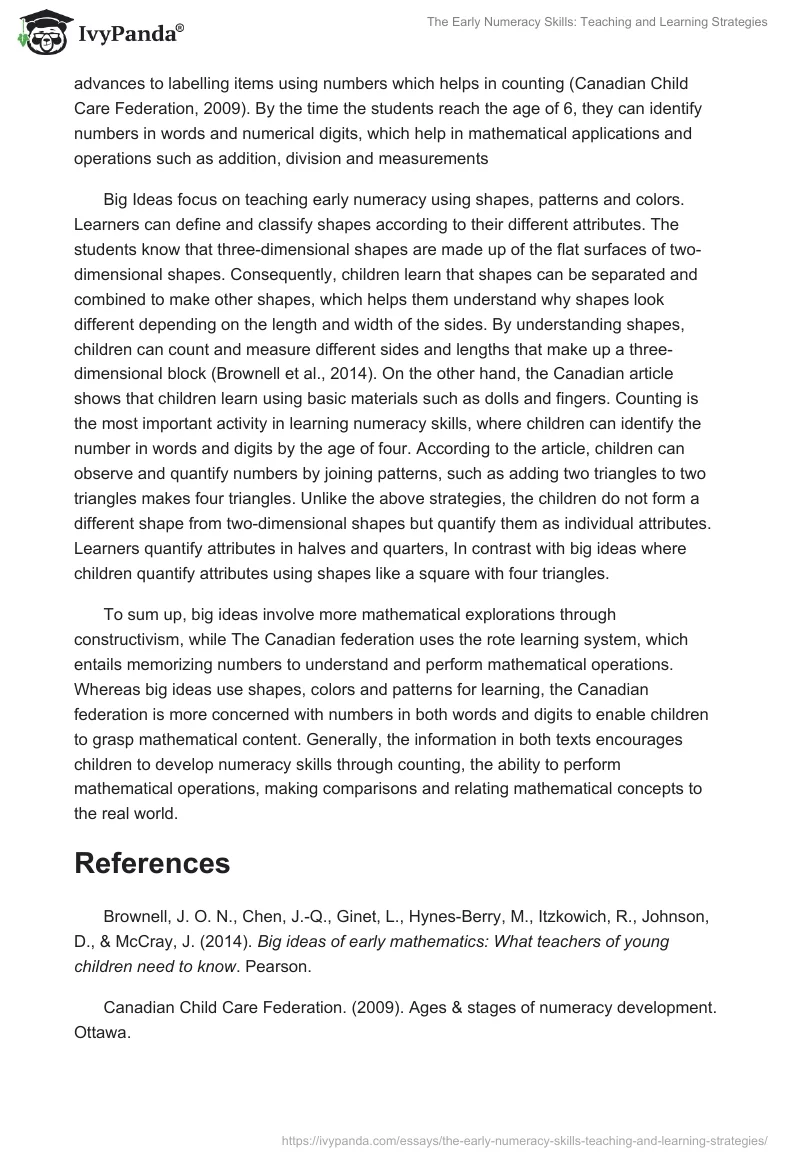Early Numeracy skills are key aspects of learning essential for understanding future mathematical concepts. Children should have adequate preparation in early education, enhancing future adaptability and academic achievement in math and other subjects. Numerous institutions use different approaches to develop numeracy skills in early education, presumed to be the most effective in the learning process and entail certain students’ expectations at each level. The Big Ideas of Early Mathematics and Canadian Child Care Federation guidelines offers appropriate strategies that comprise simpler mathematical knowledge concepts suitable for young children (Canadian Child Care Federation, 2009). Thus, this essay compares the learning activities and student expectations of numeracy skills between two- to six-year-olds.
In Big Ideas strategies, children begin with simpler mathematical knowledge concepts and advance slowly towards more complex terms and operations. The approach involves starting from a whole to part learning or a part to whole learning. For instance, the textbook provides learners with shapes that can be combined to create other shapes where the teacher starts with one triangle to create a square in class activities. When students combine two geometric shapes to form another shape, they can identify the attributes and measurements that make 2-dimensional and 3-dimensional blocks (Brownell et al., 2014). Learning becomes fun through various activities and challenges in the constructivism approach since children find different ways of solving problems that they can reflect upon when applying mathematical concepts.
Contrary to the constructivist approach, children study using the rote learning system in the Canadian federation article. Although the children learn from simple identification and counting of small numbers to larger numbers pedagogically, they are subjected to reciting and memorizing numbers in words and digital numeric. The kids can count numbers in a forward or backward order to memorize the position of each number in a sequence. Unlike the big ideas, children acquire knowledge by exploring: the Canadian federation follows the mathematical approach of learning numbers to quantify values. For instance, 2-year-old are taught numbers and their importance which advances to labelling items using numbers which helps in counting (Canadian Child Care Federation, 2009). By the time the students reach the age of 6, they can identify numbers in words and numerical digits, which help in mathematical applications and operations such as addition, division and measurements
Big Ideas focus on teaching early numeracy using shapes, patterns and colors. Learners can define and classify shapes according to their different attributes. The students know that three-dimensional shapes are made up of the flat surfaces of two-dimensional shapes. Consequently, children learn that shapes can be separated and combined to make other shapes, which helps them understand why shapes look different depending on the length and width of the sides. By understanding shapes, children can count and measure different sides and lengths that make up a three-dimensional block (Brownell et al., 2014). On the other hand, the Canadian article shows that children learn using basic materials such as dolls and fingers. Counting is the most important activity in learning numeracy skills, where children can identify the number in words and digits by the age of four. According to the article, children can observe and quantify numbers by joining patterns, such as adding two triangles to two triangles makes four triangles. Unlike the above strategies, the children do not form a different shape from two-dimensional shapes but quantify them as individual attributes. Learners quantify attributes in halves and quarters, In contrast with big ideas where children quantify attributes using shapes like a square with four triangles.
To sum up, big ideas involve more mathematical explorations through constructivism, while The Canadian federation uses the rote learning system, which entails memorizing numbers to understand and perform mathematical operations. Whereas big ideas use shapes, colors and patterns for learning, the Canadian federation is more concerned with numbers in both words and digits to enable children to grasp mathematical content. Generally, the information in both texts encourages children to develop numeracy skills through counting, the ability to perform mathematical operations, making comparisons and relating mathematical concepts to the real world.
References
Brownell, J. O. N., Chen, J.-Q., Ginet, L., Hynes-Berry, M., Itzkowich, R., Johnson, D., & McCray, J. (2014). Big ideas of early mathematics: What teachers of young children need to know. Pearson.
Canadian Child Care Federation. (2009). Ages & stages of numeracy development. Ottawa.


